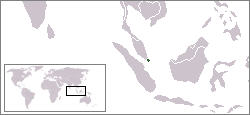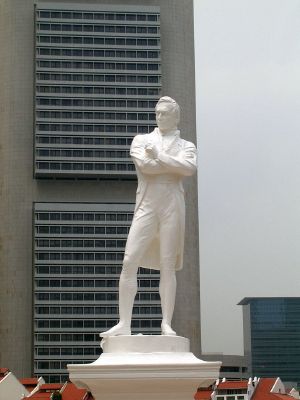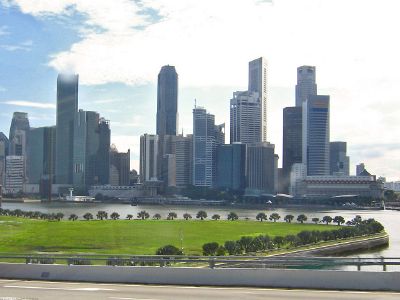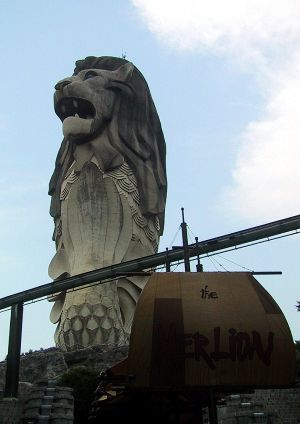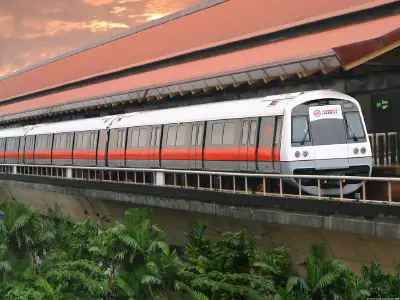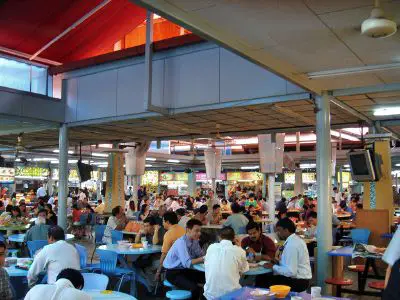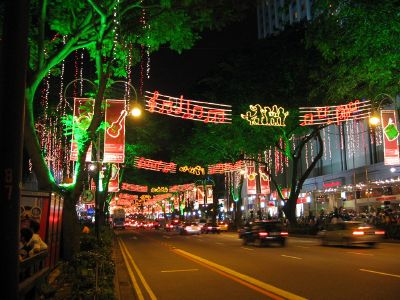Singapore
| Republic of Singapore 新加坡共和国 (Chinese) Republik Singapura சிங்கப்பூர் குடியரசு |
||||||
|---|---|---|---|---|---|---|
|
||||||
| Motto: "Majulah Singapura" Template:Ms icon "Onward, Singapore" |
||||||
| Anthem: Majulah Singapura "Onward, Singapore" |
||||||
| Capital | Singapore (Downtown Core, Central)1 | |||||
| Official language(s) | English Malay Chinese Tamil |
|||||
| Official scripts | English alphabet Malay alphabet Simplified Chinese Tamil script |
|||||
| Demonym | Singaporean | |||||
| Government | Parliamentary republic | |||||
| - | President | Tharman Shanmugaratnam | ||||
| - | Prime Minister | Lee Hsien Loong | ||||
| Legislature | Parliament | |||||
| Establishment | ||||||
| - | Founding | February 6, 1819[1] | ||||
| - | Independence from the United Kingdom | August 31, 1957[2] | ||||
| - | Merger with Malaysia | September 16, 1963[3] | ||||
| - | Separation from Malaysia | August 9, 1965[3] | ||||
| Area | ||||||
| - | Total | 722.5 km2 (191st) 279 sq mi |
||||
| - | Water (%) | 1.444 | ||||
| Population | ||||||
| - | 2023 estimate | |||||
| - | Density | 8,058/km2 (2nd) auto/sq mi |
||||
| GDP (PPP) | 2023 estimate | |||||
| - | Total | |||||
| - | Per capita | |||||
| GDP (nominal) | 2023 estimate | |||||
| - | Total | |||||
| - | Per capita | |||||
| Gini (2017) | 45.9[6] | |||||
| HDI (2021) | 0.939[7] (12th) | |||||
| Currency | Singapore dollar (SGD) |
|||||
| Time zone | SST (UTC+8) | |||||
| Date formats | dd/mm/yyyy | |||||
| Drives on the | left | |||||
| Internet TLD | .sg | |||||
| Calling code | +65 | |||||
| 1 | Singapore is a city-state. | |||||
| 2 | STD code 02 from Malaysia. | |||||
Singapore, officially the Republic of Singapore, is an island nation and the smallest country in Southeast Asia. It is located on the southern tip of the Malay Peninsula, south of the Malaysian state of Johor, and north of the Indonesian Riau Islands. It lies 85 miles (137 kilometers) north of the Equator.
According to folklore, a prince named Sang Nila Utama was caught in a storm that did not cease until he threw his crown into the water. He sailed to the closest island and the first animal he saw was a lion. He named the island Singapura. The name Singapore is derived from the Malay language words singa (lion) and pura (city). Hence, Singapore is also known as the Lion City.
The site of ancient port cities and a possession of several empires, over the past 40 years Singapore has transformed itself from a poor, politically volatile state into an economic powerhouse. According to the Economist Intelligence Unit quality-of-life index, Singapore has the highest standard of living in Asia, and is ranked 11th in the world, and is the world's 22nd wealthiest country.
A long period of stable government, investment in housing and education, and pragmatic and pro-active policies have created a modern nation that exists on the cutting edge of technological progress.
Geography
Singapore, which consists of 63 islands, is slightly more than 3.5 times the size of Washington, DC. Land reclamation has resulted in an increase of land area from 224 square miles (581.5 square kilometers) in the 1960s to 269 square miles (697.2 square kilometers) in 2007. About 23 percent of Singapore's land area consists of forest and nature reserves.
The Johor-Singapore Causeway connects Singapore to Malaysia in the north, crossing the Tebrau Straits; and Malaysia-Singapore Second Link is a bridge from western Singapore to Johor. The highest point of Singapore is Bukit Timah Hill, with a height of 538 feet (166 meters).
Singapore has a tropical rainforest climate with no distinct seasons, characterized by uniform temperature and pressure, high humidity, and abundant rainfall. Temperatures range from 72F to 93F (22C to 34C). On average, the relative humidity is around 90 percent in the morning and 60 percent in the afternoon. During prolonged heavy rain, relative humidity often reaches 100 percent.
The only remaining area of primary rainforest is the Bukit Timah Nature Reserve. A variety of parks are maintained, such as the Singapore Botanic Gardens. With no natural freshwater rivers and lakes, rainfall, collected in reservoirs, supplies approximately 50 percent of water. The remainder is imported from Malaysia or obtained from recycled water, a product called NEWater, and desalination plants.
New towns built since the 1960s have resulted in an entirely built-up and urban landscape. About 83 percent of Singapore's population lives in housing estates constructed by the Housing and Development Board.
As a result of controls on motorized traffic, the maintenance of natural greenery, and strict regulations on industrial locations and emissions, Singapore has been able to control its pollution levels to within World Health Organization standards.
History
Chinese texts from the third century C.E. contain the first records of Singapore's existence. The island was an outpost of the Sumatran Srivijaya empire and originally bore the Javanese name Temasek (which means sea town). Temasek became a significant trading city. Between the sixteenth and early nineteenth centuries, Singapore was a part of the Sultanate of Johore. During the Malay-Portugal wars in 1613, Portuguese troops set fire to Singapore.
In 1819, Sir Thomas Stamford Raffles, an official with the British East India Company, signed a treaty with the Sultan of Johore, and established Singapore as a trading post and settlement, bringing instant growth and immigration. Britain made Singapore a crown colony in 1867, and later an entrepot town, due to its strategic location along the busy shipping routes connecting Europe to China.
During World War II, the Imperial Japanese Army invaded Malaya and attacked Singapore. The British, despite having more troops, were not prepared for an attack through the dense Malayan jungle and surrendered on February 15, 1942. The Japanese renamed Singapore Shōnan and occupied it until the British repossessed the island on September 12, 1945, after the Japanese surrender.
Singapore became a self-governing state in 1959 with Yusof bin Ishak as its first head of state and Lee Kuan Yew from the People's Action Party as its first prime minister. Following a 1962 merger referendum, Singapore joined Malaysia along with Malaya, Sabah, and Sarawak in September 1963, but was expelled after heated ideological conflict with the federal government in Kuala Lumpur. It gained official sovereignty on August 9, 1965, which later became Singapore's National Day. Yusof bin Ishak was sworn in as the first President and Lee Kuan Yew remained as Prime Minister.
The fledgling nation faced mass unemployment, housing shortages, and lack of land and natural resources, including petroleum. New Minister of Finance Goh Keng Swee adopted a strategy to encourage investment with tax incentives and the establishment of a large industrial estate in Jurong. The education system was revamped to train a skilled workforce and the English language was promoted over the Chinese language.
Lee Kuan Yew, during his term as prime minister from 1959 to 1990, curbed unemployment, raised the standard of living, and implemented a large-scale public housing program. The country's economic infrastructure was developed, the threat of racial tension was eliminated, and an independent national defense system was created. Singapore evolved from a developing nation to a global city with first-world status by the end of the twentieth century.
In 1990, Goh Chok Tong succeeded Lee as prime minister. During his tenure, the country tackled the economic impacts of the 1997 Asian financial crisis and the 2003 severe acute respiratory syndrome (SARS) outbreak, as well as terrorist threats posed by the militant Islamic group Jemaah Islamiah post-September 11 attacks and the Bali bombings.
In 2004 Lee Hsien Loong, the eldest son of Lee Kuan Yew, became the third Prime Minister.
Politics and government
The politics of Singapore takes place in a framework of a parliamentary republic, whereby the Prime Minister of Singapore is the head of government, and of a pluriform multi-party system.
The president had largely a ceremonial role until 1991, when constitutional changes meant the president would be directly elected, by popular vote, for a six-year term. The president has veto powers in a few key decisions such as the use of the national reserves and the appointment of key judiciary positions.
The cabinet forms the executive, and is answerable to the Parliament. The President appoints the Prime Minister, and 16 cabinet ministers, on the advice of the Prime Minister.
A unicameral Parliament with the President as its head makes up the legislature. The 84 members of Parliament are elected for a maximum five-year term, and represent either single-member constituencies or group representation constituencies, in which political parties field a team of between three to six candidates. At least one candidate in the team must belong to a minority race. Voting has been compulsory in Singapore since 1959.
The Supreme Court consists of the Court of Appeal and the High Court. The President appoints the Chief Justice, judges of appeal, judicial commissioners and High Court judges from candidates recommended by the Prime Minister. The Prime Minister must consult the Chief Justice before recommending the judges.
The Constitution is the supreme law, and cannot be amended without the support of more than two-thirds of parliament. The President may seek opinion on constitutional issues from a tribunal consisting of at least three Supreme Court judges. Part XII of the Constitution allows the Parliament of Singapore to enact legislation designed to prevent subversion. The Internal Security Act is a law under such provision. In 1966, Chia Thye Poh, an alleged communist activist member of Parliament, was detained under this act and was imprisoned for 23 years without trial.
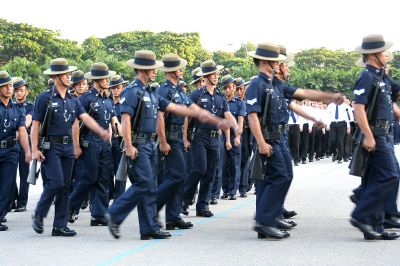
Singapore's laws derive from British and British Indian laws, and include many elements of English common law. Laws restricting the freedom of speech are justified by claims that they are intended to prohibit speech that may breed ill will or cause disharmony within Singapore's multiracial, multi-religious society. For example, in September 2005, three bloggers were convicted of sedition for posting racist remarks targeting minorities, with one sentenced to one day in jail; the second to one month; the third sentenced to probation.
Some offenses can lead to heavy fines or caning. First-degree murder and drug trafficking receive the death penalty. Amnesty International has criticized Singapore for having the highest execution rate in the world per capita.
The PAP's policies have some socialist aspects. The Housing Development Board oversees a large-scale public housing program and there is a rigorous compulsory public education system. Government-linked companies dominate the media, utilities, and public transport. Transparency International has consistently rated Singapore as the least-corrupt country in Asia.
Singapore has mutual defense pacts with several countries, most notably the Five Power Defense Arrangements. Singapore subscribes to a philosophy of Total Defense, in which five aspects of national defense are identified: Civil defense; economic defense (a robust economy); psychological defense (a patriotic citizenry); and "social defense" (a population at harmony with itself).
The Singapore Armed Forces, which includes the army, navy, and air force, is one of the most modern in Asia, with advanced equipment and high level of training reflecting the fact that military expenditure dominates the government budget annually. The Gurkha Contingent, which is part of the Singapore Police Force, is a counter-terrorist force. Singapore's defense resources have been used in United Nations peacekeeping assignments in Kosovo, Kuwait, and East Timor.
Economy
Singapore has a highly developed market-based economy, and is a developed nation. Singapore is also the fourth largest foreign exchange trading center in the world after London, New York City, and Tokyo.
The city-state employs thousands of foreign workers—Indians, Malaysians, and Filipinos. It requires talent from outside to fill the various jobs the economy is generating, most of which are in the information technology and financial sectors. The government offers easy processing time for permanent residency or citizenship.
The economy depends heavily on exports produced from refining imported goods. Manufacturing, which contributes around 28 percent of GDP, includes electronics, chemicals, mechanical engineering, and biomedical sciences. Along with Hong Kong, South Korea, and Taiwan, Singapore's fast-paced industrialization earned it a place as one of the four original "East Asian Tigers."
In 2001, a global recession and slump in the technology sector caused the GDP to contract by 2.2 percent. The Economic Review Committee set up in December 2001 recommended policy changes to revitalize the economy. Improvements in the world economy led to economic growth in the following years.
Export commodities are machinery and equipment (including electronics), consumer goods, chemicals, and mineral fuels. Export partners include Malaysia, US, Indonesia, Hong Kong, China, Japan , Thailand, and Australia.
Import commodities are machinery and equipment, mineral fuels, chemicals, and foodstuffs. Import partners include Malaysia, US, China, Japan, Indonesia, Saudi Arabia, and South Korea.
Singapore introduced a goods and services tax (GST) with an initial rate of 3 percent on April 1, 1994. This increased government revenue by $1.6 billion, stabilizing the government's finances. The government has used revenue from this tax to re-orient the economy around services and value added-goods to reduce dependence on electronics manufacturing.
Singapore is a popular travel destination, making tourism one of its largest industries. The Orchard Road district, which is dominated by multi-story shopping centers and hotels, is the center of tourism. Cuisine has been heavily promoted as a tourist attraction, along with shopping. The government organizes the Singapore Food Festival each July.
Singapore is an Asian transportation hub, and transportation accounts for over 10 percent of Singaporean GDP. Singapore's Changi Airport acts as a stopover point for the "Kangaroo route" between Australasia and Europe.
Singapore has a network of expressways. After a government study which predicted traffic congestion and air pollution, the Land Transport Authority began to improve the bus service and allowed for more taxi operators. Since 1987, the heavy rail mass rapid transit metro system has been in operation, later augmented by the light rapid transit. The EZ-Link system allows non-contact smart cards to serve as stored value tickets. Tolls discourage private vehicle use in the central area.
Demographics
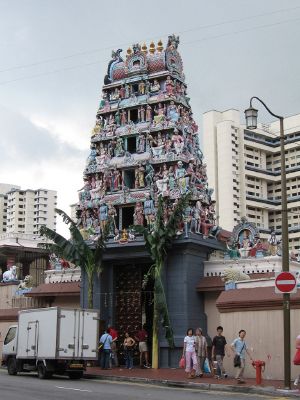
Singapore is one of the most densely populated countries in the world, with a high number of residents being non-citizens (either permanent residents or foreign students or workers). Among the residents, including both citizens and permanent residents, a significant percentage (over 20 percent) were foreign born.
The largest group in the population are the Singaporean Chinese who account for over 70 percent of the population, making it one of the largest Chinese cities outside of China. Singaporean Malays, the indigenous native group of the country, constitute approximately 13 percent. Indian Singaporeans are the third largest ethnic group , consisting of several groups — Indian Tamils and Sri Lankan Tamils, Malayalees, Punjabis and Bengalis. The rest are made up of Arab Singaporeans, Thais, Japanese, Europeans, and the Eurasian Singaporean community.
Singapore is a religious country. More than 40 percent of the population practice Buddhism. About 15 percent practice Christianity (mostly Chinese and Indians), and 15 percent profess no religion. Muslims (mostly Malays) account for 14 percent. A smaller minority practices Daoism, Sikhism, Hinduism, Baha'i Faith, and others.
The government of Singapore has been careful to maintain ethnic harmony after racial riots erupted in the 1960s. Racial harmony has been emphasized in all aspects of society, including the Singaporean education system, military, and housing. So far the policy has been largely successful, and there have been few signs of ethnic tension since the early 1970s. Current issues include the ban on wearing the Islamic headscarf in public schools.
The national language is Malay, and it is used in the national anthem, "Majulah Singapura." The official languages are English, Mandarin, Malay, and Tamil. Most public signs and official publications are in English. The local dialect of English is Singlish, incorporating vocabulary and grammar from various Chinese dialects, Malay, and Indian languages. Singlish is spoken on the streets. English became widespread after it became the language of the education system. The government has introduced a "speak Mandarin campaign," "Hua Yu Cool," to promote Mandarin as a common language among the Chinese.
After two decades of a family planning policy, Singapore is now facing the threat of an aging population with declining birth rates. The large number of immigrants, encouraged to live in Singapore by the government, has kept the population from declining.
Society and culture
Rice, fish, chicken, and vegetables are the staples, mixed with a rich variety of spices, chilis, coconuts, lime, and tamarind. The variations are endless. Food is often eaten in food centers where food is cheap, tasty, and freshly made. Malay Muslims do not eat pork, Indian Hindus do not eat beef, and many Buddhist Chinese are vegetarians. Many people do not drink alcohol.
Singapore has become a center for modern architecture as older buildings are cleared away to make space for newer, larger buildings along the coast of Marina Bay and Raffles Place. No building is to be taller than 920 feet (280 meters). A few signs of Singapore's colonial past remain in the form of "Black and White Houses," built in the early to mid nineteenth century to house the British generals and governors when Great Britain occupied the country. They became home to many Japanese generals during World War II.
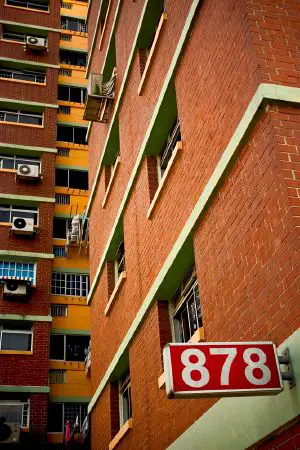
Singapore has a Little India and a Chinatown, formed under the Raffles Plan to segregate immigrants. Many places of worship were constructed during the colonial era, a practice encouraged by the British to promote religious tolerance. Sri Mariamman Temple, the Masjid Jamae Mosque, and the Church of Gregory the Illuminator were built during the colonial period.
The policy for the primarily commercial ethnic neighborhoods stands in contrast to the policies of the Housing and Development Board that attempt to promote a mix of all races within each housing district in order to foster social cohesion and national loyalty.
Primary education is compulsory in Singapore; the literacy rate is 95 percent. The Ministry of Education sets the standard for the school curriculum with a mix of private and public schools. Students take the primary school leaving examination. Their performance in the examination is the main criteria in determining whether they enter their desired secondary schools. There have been complaints about excessive educational streaming at a young age.
After secondary education, a further set of examinations are taken which determine the next step to tertiary education. Junior college is a precursor for entry into the National University of Singapore, Nanyang Technological University, and Singapore Management University. There are polytechnics, where students will graduate with a diploma and may choose to move into the workforce or pursue higher education in public universities. There is teacher training college, various management institutes, and vocational education institutes.
Singapore students took first place in the 1995, 1999, and 2003 Trends in International Mathematics and Science Study. They used the Singapore Math Primary Mathematics series. The national textbooks have been adapted into a series which has been successfully marketed in North America as a rival to other math programs and an alternative to controversial standards-based mathematics curricula.
Singapore hosts an annual Singapore Arts Festival. In 2003, the Esplanade - "Theatres on the Bay," a center for performing arts, was opened. Nanyang Academy of Fine Arts and LASALLE-SIA College of the Arts offer full-time programs for the performing arts.
Since the 1990s, a film industry has sprouted. Eric Khoo and Jack Neo, are two pioneering film makers. In particular, the movie I Not Stupid struck an emotional chord among many Singaporeans as its story highlighted many issues faced in a competitive society. In 2003, ten-year-old Megan Zheng became the first Singaporean actress to win the Taipei Film Festival Golden Horse Award for Best New Performer with her role in Jack Neo's movie Homerun.
Popular sports include soccer, swimming, badminton, basketball, and ping pong or table tennis. Most people live in public residential areas that often provide amenities including swimming pools and outdoor basketball courts, as well as indoor sport centers that provide facilities for badminton, squash, table tennis, gymnastics, indoor basketball, and volleyball, among others.
In the realm of spectator sport, soccer is king. Singapore has its own professional soccer (football) league. Launched in 1996, the S.League now consists of 10 teams competing in stadiums around the country. In 1998 and 2004, the Singapore national football team became the champions of the Tiger Cup, the premier football competition in Southeast Asia.
Singapore has won its first Olympic medal at the 1960 Rome Summer Olympics when Tan Howe Liang won the silver medal in weightlifting. At the 2016 Rio Olympics, Joseph Schooling won Singapore's first Olympic gold medal, claiming the 100-metre butterfly in a new Olympic record time of 50.39 seconds.
A National Physical Fitness Award (NAPFA) was introduced in 1982, a scheme which requires all primary and secondary students to participate. The government sponsors the Singapore Sports School which opened in 2004, combining a reduced curriculum with professional training in each student's preferred sport.
Notes
- ↑ Ernest C.T. Chew and Edwin Lee (eds.), A History of Singapore (Oxford University Press, 1991, ISBN 978-0195889178).
- ↑ Derek Mackay, Eastern Customs: The Customs Service in British Malaya and the Opium Trade (Radcliffe Press, 2005, ISBN 978-1850438441).
- ↑ 3.0 3.1 No. 8206. An Agreement Relating to the Separation of Singapore from Malaysia as an Independent and Sovereign State United Nations Treaty Series. Retrieved October 6, 2023.
- ↑ Population and Population Structure Department of Statistics Singapore. Retrieved October 6, 2023.
- ↑ 5.0 5.1 5.2 5.3 World Economic Outlook Database, April 2023 Edition International Monetary Fund. Retrieved October 6, 2023.
- ↑ CIA, Distribution of Family Income – GINI Index The World Factbook. Retrieved October 6, 2023.
- ↑ Human Development Report 2021/2022 United Nations Development Programme. Retrieved October 6, 2023.
ReferencesISBN links support NWE through referral fees
- Chew, Ernest C.T., and Edwin Lee (eds.). A History of Singapore. Oxford University Press, 1991. ISBN 978-0195889178
- George, Cherian. Singapore: The Air-Conditioned Nation. Essays on the Politics of Comfort and Control. Landmark Books, 2000. ISBN 981306546X
- Mackay, Derek. Eastern Customs: The Customs Service in British Malaya and the Opium Trade. Radcliffe Press, 2005. ISBN 978-1850438441
- Mauzy, Diane K. & R. S. Milne. Singapore Politics: Under the People's Action Party. Routledge, 2002. ISBN 0415246539
- Powell, Robert. Singapore Architecture: A short history. Hong Kong: Periplus Editions (HK) Ltd, 2004. ISBN 0794602320
- Worthington, Ross. Governance in Singapore. New York; London: Routledge/Curzon, 2002. ISBN 070071474X
External links
All links retrieved October 6, 2023.
- Singapore Countries and Their Cultures
- Singapore US Department of State
- Singapore The World Factbook
- Singapore Nations Online
- Singapore Government
- Singapore Tourism Board
Credits
New World Encyclopedia writers and editors rewrote and completed the Wikipedia article in accordance with New World Encyclopedia standards. This article abides by terms of the Creative Commons CC-by-sa 3.0 License (CC-by-sa), which may be used and disseminated with proper attribution. Credit is due under the terms of this license that can reference both the New World Encyclopedia contributors and the selfless volunteer contributors of the Wikimedia Foundation. To cite this article click here for a list of acceptable citing formats.The history of earlier contributions by wikipedians is accessible to researchers here:
The history of this article since it was imported to New World Encyclopedia:
Note: Some restrictions may apply to use of individual images which are separately licensed.


